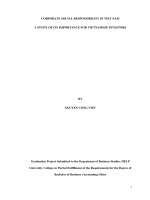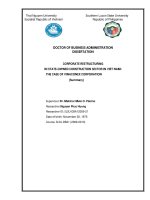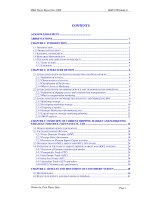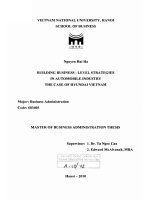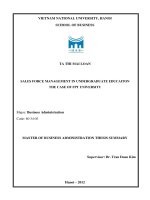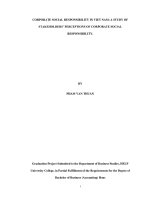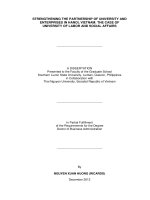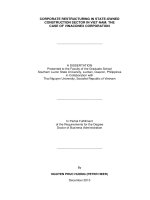corporate restructuring in stateowned construction sector in viet nam the case of vinaconex corporation
Bạn đang xem bản rút gọn của tài liệu. Xem và tải ngay bản đầy đủ của tài liệu tại đây (1.62 MB, 24 trang )
Thai Nguyen University Southern Luzon State University
Socialist Republic of Vietnam Republic of Philippines
DOCTOR OF BUSINESS ADMINISTRATION
DISSERTATION
CORPORATE RESTRUCTURING
IN STATE-OWNED CONSTRUCTION SECTOR IN VIET NAM:
THE CASE OF VINACONEX CORPORATION
(Summary)
Supervisor:Dr. Melchor Melo O. Placino
Researcher:Nguyen Phuc Huong
Researcher ID: SLSU-DBA12009-21
Date of birth: November 30, 1975
Course: SLSU-DBA1 (2009-2013)
2
Chapter I: INTRODUCTION
1.1. Background of the study
In Viet Nam, the State Owned Enterprises (SOEs) are holding a key role in the national economy
and is making an important political mission in the country. SOEs have occupied a big resource
of the economy; however, the profitability from state capital is limited. Many SOEs have been
latent risk and disruption.
Government, ministries, industries, including the construction industry has project for
restructuring the economy. The construction sector corporations also simultaneously make plan
for restructuring the economy of its business; but actually implementing specific process for
restructuring the economy in the construction business are confused, and have not actually
achieve the desired effect.
Currently, Vinaconex is a corporation headed scale construction sector in Vietnam. Vinaconex
Corporation is kind of Joint-Stock company with controlled shares owned by State (> 51%).
Vinaconex recently has been processing corporate restructuring; however in the process of
corporate restructuring, Vinaconex Corporation has faced many of the problems that the
previous inadequacies were not fully foreseen.
This is the reason for carrying out the study of: “CORPORATE RESTRUCTURING IN STATE-OWNED
CONSTRUCTION SECTOR IN VIET NAM: THE CASE OF VINACONEX CORPORATION”.
1.2. Objectives of the study
This research explores and indicates five objectives:
1. To determine the awareness of the managers of Vinaconex Corporation on the concept
and the implementation of the corporate restructuring in state-owned firms in Vietnam.
2. To identify the main factors/problems and issues that affects the process of corporate
restructuring at Vinaconex Corporation.
3
3. To examine the effects on the ownership structure on the corporate restructuring of the
construction sector in the SOEs.
4. To propose the most appropriate model for Vinaconex after restructuring.
5. To formulate policy suggestion to the government's to support business sector in corporate
restructuring.
1.3. Research Questions
This study intends to answer the followings questions:
Q1: How do Vietnamese managers perceive and interpret corporate restructuring?
Q2: What framework (factors/problems and issues) is used in analyzing corporate
restructuring in Vietnam SOEs?
Q3: How restructuring in the construction sector in SOEs affect the state shareholders and
the ownership structure?
Q4: What is the most appropriate model for VINACONEX Corporation after
restructuring?
Q5: What policy can be suggested in order to support a successful SOEs restructuring?
1.4. Hypotheses
The following hypotheses are outlined and tested by using statistical methods to answer the
research questions and to orientate the survey and data collection.
H1: Restructuring will improve the competitiveness of the company on its core business.
H2: Restructuring will improve the situation on current ownership of the company.
H3: Restructuring will improve the leadership and human resource management of the
company
4
1.5. Scope and Limitation of the Study
Subject of the study are Vinaconex Corporation (including the head-office and all subsidiaries of
Vinaconex).
The actual survey data (primary) are conducted during the period from May, 2013. The secondary
data are based on national statistics and company reports from 2010 to 30 June 2013.
1.6. Structure of the Study
The dissertation consists of five chapters including:
- Chapter 1: Introduction
- Chapter 2: Literature review
- Chapter 3: Methodology
- Chapter 4: Results and Discussion
- Chapter 5: Findings, Recommendations and Conclusion.
5
Chapter II: LITERATURE REVIEW
Restructuring of state-owned enterprises in general and specialized management enterprises in
particular has been an issue concerned by international and national researchers, learners and
managers and also a topic referred in international and national conferences. Some relevant
researches are as follows:
1.1. International related research
1.2. National related research
1.3. Theoretical and conceptual framework
The concept of "change management" is a familiar one in most businesses today. But, how
businesses manage change (and how successful they are at it) varies enormously depending on
the nature of the business, the change and the people involved. And a key part of this depends on
how far people within it understand the change process.
One of the cornerstone models for understanding organizational change was developed by Kurt
Lewin - a physicist as well as social scientist who explained organizational change using the
analogy of changing the shape of a block of ice. Kurt Lewin’s Change Management Model
consist three stages of change: Unfreeze – Change – Refreeze.
To begin any successful change process, you must first start by understanding why the change must
take place. As Lewin put it, "Motivation for change must be generated before change can occur.
One must be helped to re-examine many cherished assumptions about oneself and one's relations to
others." This is the unfreezing stage from which change begins.
1.4. Analytical framework
Organizational restructuring involves major changes in the organizational structure for enhancing
the ‘efficiency and effectiveness’ of firms (Bowman & Singh, 1993). It involves reorientation of the
business units to rearrange resources within a firm for better performance. According to Gibbs
6
(1993), there are three types of corporate restructuring includes: (i) financial restructuring including
recapitalizations and changes in capital structure; (ii) portfolio restructuring involving refocusing on
core business, resulting in change of the diversity of business in the corporate portfolio; and (iii)
operational restructuring including reorganization and changes in business level strategies.
Corporate restructuring is intended to either reacting to crisis or to be part of the company’s pre-
emptive plan for their survival in the industry. Restructuring process is a lengthy and a painstaking
one. It presents many challenging tasks and requires analysis of social benefits and costs. The most
difficult task is to persuade the most suffered to understand the desirability of the reform efforts
(Soon, 2004). In the mean time, strategic evaluation of re-engineering, restructuring and
downsizing policies are perceived as the influential management paradigm. With this, companies
are able to fully leverage on their core competences in creating superior competitiveness (Tony,
1997).
Miller and Friesen (1984) suggested that the environment shift, technology changes, organizational
grow and leadership changes are the reasons that lead to restructuring. Massimo and Delmastro
(2002) deemed that the adaptation of advanced manufacturing technology and new human resource
management practices favors organizational change. Miles, Covin an Heeley (2000) suggested that
environmental dynamism impacts the strategies chosen by firms and moderates the relationships
between organizational structure, organizational strategies, and firm performance. Moers (2000)
suggested that restructuring is also associated with strong market competition. Jensen (1986)
believed that the restructuring could be described as returning free cash flows to owners. The work
of Hariison et, al. (1991) suggested that a significant amount of restructuring is associated with high
levels of diversification strategies, while the study of Hoskisson and Turk’s (1990) concluded that
restructuring is primary directed at overcoming control problems that are associated with
diversification and that result in poor performance. It is partially explained by free cash flow
because free cash flow is a function of investment opportunity, operating cash flow, diversification,
financial leverage, and corporate governance. Hill and Snell (1988) found that ownership
7
concentration was associated with lower levels of diversification in research and development-
intensive firms. Thus ownership diffusion is positively related to diversification. Based on this
literature, we proposed an analyzing framework indicating the relationship between the dependent
variable (corporate restructuring) and independent variables is presented in figure 1.
8
Chapter III: METHODOLOGY
This chapter presents the methods used for this research. The methods in use show a combination
between quantitative and qualitative research. Data include secondary data from statistical reports
and primary data from survey by questionnaires.
3.1. Overview of the Vinaconex Corporation
- Established: 27 September 1988 under Ministry of Construction formerly known as the
building service and manpower export company
- In 1995, Vinaconex became a Corporation 90 of the Ministry of Construction, called:
Vietnam construction, import and export Corporation.
- Make the Decision dated 05.13.2004 84/2004/QD-TTg of the Prime Minister, Vinaconex
is one of the State Corporation first pilot equalization of the whole company. November
27, 2006, Congress established the General Shareholders Company has been conducted
and Vinaconex has officially come into operation in the form of joint-stock company
- Currently VINACONEX has conducted corporate restructuring. They have 58 units of
attached units in which 33 subsidiaries with dominant capital (over 51%) operate
nationwide with a staff of over 34,000 staffs, engineers, professionals and workers.
- Field operations: Construction, Real – Estate, Production of construction materials; design
consultancy; supply power and water; Insurance; Finance and Banking; Service, trade,
Education…
- Charter capital: 210,33 US millions dollars (4.417 billion VND)
- Owner equity: 233,24 US million dollars (4.898 billion VND)
- Total Assets: 1.353,14 US million dollars (28.415 billion VND)
9
3.2. Determination of sample
This study used stratified sampling method at enterprises under Ministry of Construction, some
corporations, groupespecially focusing on Vietnam Construction and Import-export Joint Stock
Corporation – VINACONEX and other companies under the Corporation Vinaconex.
The author uses the Slovin’s formula to define the sample size for the survey:
n=
2
1
Ne
N
40039,395
)05,0(*342011
34201
2
(population)
Where n: sample size
N: Population size that is more than 34 millions totals staffs of Vianconex.
e: Probability of error committed due to the use of sample instead of population. The error
level in sample survey was chosen to be at 5%.
Thus, the sample size of the survey is 400 respondents.
3.3. Research design
- The questionnaire was developed based on the analyzing framework above.
- It consists of 35 statements related to competition, financial, corporate governance, new
business strategies, human resource management, conflict, ownership, leadership, technology
development… in order to gain in-depth knowledge on the issues.
- The typical five-level Likert item (Agreement scale: 1=strongly disagree, 2=disagree,
3=neither agree nor disagree, 4=agree, 5=strongly agree) was used for this study
- 400 questionnaires were sent to senior manager, medium level manager and non-
managerial staff of the selected of Vinaconex, other construction state-owned enterprises
and some leaders of Ministry of Construction of Vietnam.
- Use both SPSS and EXCEL for data processing.
10
Chapter IV: RESULT AND DISCUSSION
4.1. Description of respondents
- The table below indicates that majority of respondents are males (91.25%) and only 8.75
% are females (35/400 persons). Of which over 52.6% of males are at the age of 50 or
older (higher than the average level 50%) and only 23% of females are of this age.
- Regarding job position: 27.75% are senior executives; 32% are managing directors and
40.25% are officers. This shows that most of respondents of the questionnaires are
relevant to restructuring process in enterprises and nearly 60% of them are executives,
directors or managers of various levels. It can be said that through these samples, the
survey results are appropriate with the reality and will reflect reliably the research
theme.
- Age structure based on job position:
Senior executives Managing Director Officers
11
- The study shows that the average age of senior executives is much higher than that of
managing directors and officers. Therefore, there will be different opinions about
corporate restructuring.
4.2. Verification of rating tools
- All content of the questionnaires (except for the general information about respondents)
use Likert (order rating tool) for 35 items with 5 levels reflecting the consent of the
respondents.
- The verification followings shows that Cronbach’s Alpha indicator is > 0.6, meaning that
the rating tool used in the questionnaires are reliable and can be used as data for analysis.
Cronbach's
Alpha
Cronbach's Alpha Based on
Standardized Items
N of Items
0.693 0.679 35
4.3. Analysis on each issues relating to restructuring process
The content relating to restructuring process in SOE in the construction industry are categorized
in 10 major issues including:
4.3.1. Reasons for restructuring of SOEs in the construction industry of VietNam
The study show that majority of respondents strongly agreed that the restructuring resulted
from their urgent needs which aimed to help them come out of recession, or avoid bankruptcy,
etc. The average level is 4.62/5, which is a highly concentrated level. In general, 362/400
respondents (accounting for 90%) agreed with this reason.
Meanwhile, only 36 respondents (9%) agreed that the restructuring came from pressures and
requirements of the Group/Parent Company/State Capital management
Company/Industry/Government, etc. and 77 respondents (19%) agreed that the restructuring
arisen from themselves with an objective of self-renewal for suitable with their strategy and the
12
needs of the business development – identifying that restructuring was an indispensable phase
in the development process of the company. The average rating level of these 2 reasons are
fairly low (2.74 and 2.58 respectively). Therefore, it can be concluded that the objective for
enterprises to get out of recession or threat of bankruptcy is the basic reason for their
restructuring. However, officers in different job positions have different attitudes.
It can be easily realized that percentage of senior executives agreeing strongly with the above
reason are high (83.73%), but reduce gradually among managing directors and officers. Hope
that with this consent on the reason for restructuring as such, they can easily cooperate with
each other during the restructuring process.
4.3.2. Competition
Regarding competition, as enterprises implement restructuring, majority of respondents (average
agreeing level of 4.64) agreed that the restructuring helped companies focus their resources on
their competitive products in the market. On the contrary, most of opinions (over 75%) disagreed
that the restructuring helped companies focus on improving customer service quality, and
enhancing companies’ image and trademark. This shows positive awareness of officers in the
construction industry, who know that the restructuring is not an appearance or image but must be
real and enhance their enterprises.
As such, in terms of competition, the corporate restructuring is aimed at helping companies focus
their resources on their competitive products in the market. Therefore, there’s a need to share with
each other about the situation and policy for better understanding and consent on implementation.
4.3.3. Strategy
It is obvious that 315 respondents agreed that in the context of Vietnam, the construction
companies should focus on their core business areas related to the construction industry with an
average agreeing level of over 4.
13
On the contrary, many respondents disagreed with the opinion that restructuring should decisively
implement merger, closure or withdrawal from those business areas which were not profitable.
The same was as with the opinion that construction companies in Vietnam should expand their
business into developing country markets where infrastructure and the construction were still
under developed.
Regarding strategy, construction companies should focus on their core business areas related to
the construction industry. There is a difference among respondents of different job positions. The
almost of senior executives agreed with this strategy and 76.6% of them strongly agreed with the
opinion while percentage of managing directors and officers was only approximately 20%.
The verification results show that there is actual difference in opinions of respondents in different
job positions, which shall easily lead to conflicts during implementation of strategies and
restructuring process.
4.3.4. Conflict
During restructuring, there will certainly be several conflicts between the management team,
unions and the laborers as well as conflicts regarding perception and benefits, etc.
The study shows the most concern of many people that restructuring is essentially to dismantle
and replace the old structure with a new one, so that the conflict of perception and/or benefits will
occur vigorously. Any industry when implementing restructuring always copes with this matter.
Moreover, restructuring shall require the companies to cut off staffs that mean they will also face
fierce resistance from a number of their owned managers and employees, which is an issue that
capture much attention and obtain agreement by many respondents. As for them, propaganda,
seeking consensus from the political organizations, group of leaders and workers in the
companies shall play an important role for success of the restructuring.
The concern about the fact that some of key personnel as well as qualified and skilled staffs may
leave the company in the process of restructuring are also mentioned but at average level.
14
According to the author, this is reasonable as during restructuring, we should implement
propaganda so that all subsidiaries under the corporation can see their benefits as well as show
their consensus.
It is notable that most of senior executives agreed that restructuring shall create conflicts in
perception and benefits vigorously yet nearly 29% of managing directors and over 35% of
officers ignore and disagree with the issue.
4.3.5. Ownership:
The role of owners of the company also has impact on the restructuring results.
It is concluded that majority of respondents (nearly 80%) agreed with the opinion that the
profound understanding and compatibility of business operation fields of those organizations/
companies who owned the shares of the company, should substantially affect the success or
failure of the company with a high agreeing level of 4.27 and consensus by all of 3 categories of
staffs.
In addition, the role of the state shareholder’s representatives are not effective enough in the
companies where the State holds majority of shares (>51%), which were agreed by more than
74% of respondents. More than 50% of respondents disagreed with the opinion that enhancing
the role of independent directors in the BOM should help the restructuring on the right track and
improve risk management of the Company. The Companies should review the role, impact and
effectiveness of independent BOM members.
4.3.6. Leadership:
The leaders play an important and direct role to success or failure of the corporate restructuring
process.
15
There are 358 out of 400 respondents (nearly 90%) confirmed that the qualification, knowledge
and the profession of BOM members in the operation fields of the companies shall greatly impact
on the success of the restructuring.
When restructuring and merging, who are the leaders are important and always paid much
attention. However, it does not mean that “Replacing of leaders happened in vast majority of
companies conducting restructuring”. Many respondents disagreed with this opinion (average
agreeing level of 2.33). According to the author, as restructuring, it’s not essential for companies
to replace leaders but choose those with appropriate capacity and qualification. Therefore, in
reality, replacement of leaders is sometimes necessary while sometimes is not.
The study shows that there is a difference in opinions of respondents in different job positions
(5%). Several officers and managing directors disagreed with the opinion that the qualification,
knowledge and the profession of board members in the operation fields of the companies should
greatly impact on the success of the restructuring.
4.3.7. Employment
The employment is a sensitive issue during restructuring process.
Most of respondents agreed that restructuring meant the downsizing of staffs of the Companies
with a fairly high average agreeing level (4.08). The opinion that restructuring is an opportunity
to appropriately adjust key positions in the companies, and it is the right time to attract high
quality human resources from outside the Companies was at slightly lower level (3.63).
According to the author, attention is paid too much to the form of changes; therefore downsizing of
staffs is often the 1st choice. However, it’s not the issue of downsizing of staffs but of how
appropriately and effectively the personnel with high qualification is arranged.
Regarding this issue, there is a significant difference in opinions of respondents in different job
positions. While 31.53 % of senior executives view this to be normal and 1.8% of them totally
16
agreed with the opinion, only 13.75% and over 24% of officers strongly agreed with and consider
this to be normal respectively.
4.3.8. Technological Innovation
It should not wait until restructuring to carry out the technological innovation” were agreed the
most with 84% of respondents (among which over 54% strongly agreed and nearly 30% agreed).
From this, it is well aware that technological innovation is essential not only in restructuring and
is one of the leading issues of the restructuring.
The opinion is “Technological innovation should be carried out continuously. It should not wait
until restructuring to carry out the technological innovation” were agreed the most with 84% of
respondents.
The opinion that “Restructuring relating to technology should define that “technological
innovation should be carried out as soon as the current technology is not yet backward” was
also agreed by many respondents. Only 20% of respondents disagreed with the opinion with
average agreeing level of 3.46. This is reasonable in the current context of Vietnam.
4.3.9. Corporate Governance
Regarding this issue, most of respondents agreed that restructuring relating to corporate
governance was to comprehensively reform the management approach and methods in the
companies rather than to establish and build uniform regulations and procedures for meeting the
strategy of the Company in accordance with implement roadmap of the restructuring.
The above results show that different categories of staff have different opinions regarding the
issue. The officers agreed with the reforming of management approach and methods at higher
level than senior executives.
4.3.10. Finance
17
Most respondents were concerned about the policies of state on capital preservation requirements
for selling shares or conducting merger which were creating obstacles for the restructuring
process. For the same reason, they agreed with the opinion that there should be a specific policy
regarding "capital preservation requirements" for selling projects/shares of state owned
enterprises/companies with control shares owned by state. Additionally, about 40% of respondents
wished to have a flexible policy of state on purchase and sale of debts in order to help companies to
accelerate the restructuring process.
4.4. Analysis of different in opinions of staffs at different ages about key issues
No. Issues
Ranges of age
20-29 30-39 40-49
50 and
older
1
Corporate restructuring due to recession
4.19
4.28
4.82
4.77
2
Helping companies focus their resources on their
competitive products in the market
4.50 4.43
4.72
4.72
3
Focusing on their core business areas
3.38
3.47
4.32
4.29
4
Conflicts in perception
3.5
3.6
3.97
4.22
5
Qualification of BOM members
4.04
3.85
4.72
4.33
6
The role of majority shareholders
3.92
3.89
4.42
4.08
7
Impact of
knowledge of BOM members on
success
4.19 4.17
4.70
4.57
8
Restructuring means the downsizing of staffs of
the Companies
3.42 3.89 4.12
4.23
9
Technological innovation requirements
3.54
3.69
4.50
4.09
10
Frequent and continuous technological innovation
4.38
4.40
4.29
4.41
11
Reforming the management approach and
methods
4.19 4.26 4.20
4.39
18
12
Capital preservation requirements of enterprises
3.62 3.96
4.55 4.52
13
Capital preservation policies of enterprises
4.23 4.21
4.71
4.60
The above table shows that most of issues obtained the highest level of agreement by
respondents between 40 – 49 age ranges. The younger respondents often had lower level of
agreement, which indicated that people at the age between from 40 to 49 can be exploited during
the restructuring process …
Chapter V: FINDINGS, RECOMMENDATIONS AND CONCLUSIONS
5.1. Findings of study
Based on the results have been analyzed in Chapter IV, research indicated the following
findings:
1. The research pointed out that the perception on definition, method and timing for
corporate restructuring of managers in state-own construction enterprise in general
and Vinaconex Corporation in particular is limited.
2. The author developed a theory framework on corporation restructuring with 10 major
variables; In which, the research identified and analyzed 13 basic factors to handle
when carrying out corporate restructuring in state-own construction enterprise in
Vietnam.
3. The research also introduce opinions regarding the negative effects on corporate
restructuring result when individuals/ organizations/ corporations are assigned by the
Government to represent the state’s shares of capital without any compatible
knowledge or expertise in the core business of the Corporations they are assigned to
represent the state-own capital.
19
4. The author proposes a most appropriate model for Vinaconex after restructuring with
the following major contents:
The Corporation should only focus on core businesses which are real estates
and construction - including support businesses like design services and urban
management, etc.
The Corporation needs to reduce representatives, transfer its shares at firms not
operating in the core businesses of the Corporation; at the same time, increase
shares at the flagship firms which the Corporation keeps control to gain better
competitiveness.
The Corporation must focus its resources on technology advancement -
upgrade the system when the technology has not been outdated. Moreover, it
also needs to renew and apply an uniform management policy to match with
that of developed countries’ enterprises.
5. The Government of the S.R. of Vietnam has no enough policies and guidelines on
trading, merging and acquisition that support state-owned firms to a holistic corporate
restructuring.
5.2. Application feasibility and recommendations for further studies
1. Application feasibility
- Vinaconex Corporation and other construction firms can take as reference and apply the
post-restructuring model proposed in this study.
- Provide scientific basis or reference to consult for the managers of the construction firms
when they decided or engage to perform corporate/industry restructuring.
- Reference documents for lecturers and students; for policy makers on corporate
management on the topic of “State-owned Enterprises Restructuring”.
2. Recommendations for further studies
20
- On methodology: for further studies, other researchers may consider other variables in
addition to the 10 variables/factors used by the author in this study.
- On scope and limitation: further studies can consider to made an investigations or
research in the other industry level as well as other fields or industry or economy aside
from the construction industry.
- On research instruments: further studies can consider to utilized other instruments such as
interviews, secondary data, FGD, and others not limited to the Five-level Likert scale.
5.3. Conclusion
- Vinaconex needs to focus on two major business areas to achieve its vision which is to
become the leading company in the area of development, investment and management of
Construction and Real Estate.
- Implementation of corporate restructuring in accordance with the actual conditions of SOEs
and construction market situation in Vietnam is now an essential requirement and is the only
way to change business itself new, effective in the business;
- Develop effective management mode, transparent to avoid risks better. The implementation
of the restructuring initiative will help Vinaconex future development as outlined ambitious.
- Develop strategies for long-term financial management to ensure the sustainable
development of the corporation. Company need clear organizational structure, focusing on
the areas of core business strategy, leveraging the development of key sectors of the
Corporation.
- Manage and better control by increasing accountability for the operation of each unit
member. In addition, transparency in corporate governance to help investors better
understands the Vinaconex Corporation.
21
- System planning and financial management will help to focus the allocation of resources
in an efficient manner, funding conditions for financial management and coordination at
the level of the better companies.
REFERENCES
Abbess F. Alkhafaji, 1992. Corporate restructuring and the U.S. economy: a viewpoint,
International Journal of Commerce and Management, 2(1/2), 28 – 42.
Achleitner, A.K. 2000. Handbuch Investment Banking. Wiesbaden: Gabler 2000.
Bowman, E. H. and H. Singh. 1993. Corporate Restructuring: Reconfiguring the Firm. Strategic
Management Journal 14, 5-14.
Cappelli, P, 1995. Rethinking employment, British Journal of Industrial Relations, No.33, pp.
564
Cascio, W.F, 2002. Strategies for responsible restructuring, Academy of Management Executive,
Vol. 16 pp.80-91.
Central Committee of Communist Party of Vietnam, 2011. Resolution of 3rd Conference – 11th
Central Committee of Communist Party of Vietnam dated October 10th 2011
Charifzadeh, M. 2002. Corporate Restructuring:Ein wertorientiertes Entscheidungsmodell.
Lohmar: Josef Eul Verlag 2002.
CIEM, 2006. Vietnam’s Economy in 2005. Central Institute of Economic Management. Hanoi,
Vietnam
22
Collins, N, 2005. Economic reform and unemployment in Vietnam. In J. Benson & Y. Zhu
(Eds.), Unemployment in Asia (pp. 176–193). London and New York: Routledge.
Diana R. Franz, Dean Crawford, Deborah J. Dwyer, 1998. Downsizing, Corporate Performance, and
Shareholder Wealth, American Journal of Business, Vol. 13 Iss: 1, pp.11 - 20
Ding, X. L, 2000. The Illicit Asset Stripping of Chinese State Firms, China Journal, 43 (January),
1–28.
E.Dockery, W.E.Herbert, 2000. Corporate governance and corporate restructuring in transition
economies: evidence from privatized Polish companies, Managerial Finance, Vol. 26 Iss: 9,
pp.80 – 92;
Gibbs, P 1993, 'Determinants of Corporate Restructuring: The Relative Importance of Corporate
Governance, Takeover Threat, and Free Cash Flow', Strategic Management Journal, 14(1), 51-68.
GOS, 2008. Education, Health, Culture and Living Standards Report (Hanoi, Vietnam: Statistics
House).
GOS, General Office of Statistics 2008. Education, Health, Culture and Living Standards Report
(Hanoi, Vietnam: Statistics House).
Government of Vietnam, 2012. Directive No. 03/CT-TTG dated January 17th 2012 of the Prime
Minister on stepping up the Restructuring of State
Harrison, J., Hitt, M. A., Hoskisson, R. E., & Ireland, R. D. 1991. Synergies and post-acquisition
performance: Differences versus similarities in resource allocation. Strategic Management
Journal, 17(1), 173-190.
Hill, C.W.L. and Scott A. Snell. 1988. External Control, Corporate Strategy, and Firm Performance
in Research Intensive Industries. Strategic Management Journal 9(6), 577-590.
Hoskisson, R.E. & Turk, T. 1990. Corporate restructuring: Governance and control limits of the
internal market. Academy of Management Review, 15, 459-477.
23
Jensen, M. 1986. Agency cost of free cash flow, corporate finance and takeovers. American
Economic Review Papers and Proceedings, 76, 323-329.
Jun Zhao, 2009. Diversified business groups and corporate restructuring in China, Management
Research News, Vol. 32 Iss: 9, pp.874 – 887;
King, D.R., Covin, J.G., and Hegarty, W.H. 2003. Complementary resources and the exploitation
of technological innovations. Journal of Management, 29(4), 589-606.
Lee, C. K, 1999. From Organized Dependence to Disorganized Despotism: Changing Labor
Regimes in Chinese Factories, China Quarterly, 157(3), 44–71.
Luc Moers. 2000. "Determinants of Enterprise restructuring in Transition: Description of a
Survey in Russian Industry," Tinbergen Institute Discussion Papers 00-026/2, Tinbergen Institute.
Martyn A.Ould, 1995. Business process: modelling and analysis for restructuring improvement,
John Wiley & Sons Inc.
Massimo G. Colombo & Marco Delmastro. 2002. The Determinants of Organizational Change
and Structural Inertia: Technological and Organizational Factors. Journal of Economics &
Management Strategy, 11(4), 595-635.
Miller, Danny and Friesen, Peter H. 1984. A Longitudinal Study of the Corporate Life Cycle,
Management Science, 30 (10), 1161-1183
Morris, J.R., Cascio, W.F., Young, C.E. (1999). Downsizing after all these years: questions and
answers about who did it, how many did it, and who benefited from it. Organizational Dynamics,
Vol. 27 pp.78-87.
Painter, M, 2003. The Politics of Economic Restructuring in Vietnam: The Case of State-Owned
Enterprise “Reform”, Contemporary Southeast Asia, Vol. 25(1) pp.20-43.
Soon, S. Y. 2004. The restructuring of the Korean economy following the financial crisis in 1997.
International Journal of Management, 21(2), 232-239.
24
Thang, N.N., & Quang, T., 2007. International Briefing 18: Training and Development in
Vietnam, International Journal of Training and Development, 11(2), 139–149.
Tony, M. 1997. A strategic evaluation of re-engineering, restructuring, delayering and
downsizing policies as flawed paradigm. Management Decision, 35(3), 240-249.
Zu, L., 2009. Corporate Social Responsibility, Corporate Restructuring and Firm's Performance
– Empirical Evidence from Chinese Enterprises. Heidelberg: Springer
